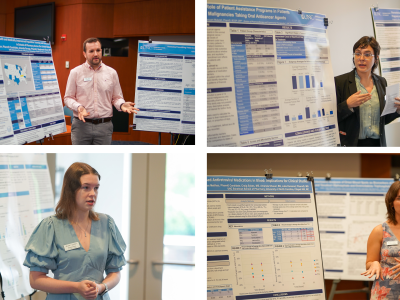June 26, 2013
Researchers and practitioners at the UNC Eshelman School of Pharmacy and UNC Hospitals have received a Pharmacy Practice Model Initiative Demonstration Grant from the American Society of Health-System Pharmacists Foundation to investigate the what, why, and how of a new model of pharmacy practice.

The one-year, $25,000 grant will support a qualitative study to examine variations of the layered learning practice model, or LLPM, at UNC Hospitals to help develop a consistent approach that will lay the groundwork for broad-scale implementation of the model, says Nicole Pinelli, PharmD, the principal investigator on the grant.
“When the LLPM was rolled out at UNC, clinical specialists designed and implemented several approaches to engaging and educating learners in the care of patients, and these models vary greatly across practice settings and specialty areas,” says Pinelli, a clinical assistant professor at the School and a clinical pharmacy specialist at UNC Hospitals.
“The purpose of this study is to understand what our pharmacists are doing and what they consider to be the core elements of an LLPM.”
Pinelli says the idea is to systematically collect the data and use it to work with clinicians to develop a recognizable, consistent approach to practice that is practical, scalable, and adaptable to different settings.
“The key is not to develop a service but to develop a consistent approach to practice for the LLPM: How do we run it? Who’s involved? What are the roles and responsibilities? What care is consistently provided to patients? What are the teaching and learning strategies consistently applied in training students and residents?” she says.
“Having that consistent approach is not only important for the hospital but perhaps even more important for the profession.”
What is the LLPM?

In the traditional pharmacy practice model at UNC Hospitals, a patient-care team on rounds includes one clinical pharmacy specialist who is sometimes accompanied by a resident or a student. In an LLPM, the clinical pharmacy specialist acts as an attending pharmacist who oversees a team of pharmacy trainees that includes residents in postgraduate year one or two and fourth-year pharmacy students. Instead of passively shadowing the pharmacist as in the traditional model, the learners in an LLPM assume a much more active role in patient care.
“The idea is that by having multiple people on the pharmacy team, we could offer comprehensive medication therapy management, improve care coordination, and provide additional services that would not be possible in the old model,” Pinelli says.
“From the learning perspective, the major difference is that we are trying to have the more experienced learner — the PGY1 or PGY2 residents — have direct preceptorship responsibility for the less experienced learner, the PY4 students.”
Pinelli says the LLPM will be especially important in the future as the School prepares to launch a new curriculum, in which early clinical immersion in patient care will begin in the students’ second year and continue into the third and fourth years.
The LLPM arose from the Partnership in Patient Care between the School and UNC Hospitals, which aims to increase pharmacy services for patients, learning opportunities for students, and the amount and quality of point-of-care research. The LLPM builds upon a new practice model that earned UNC Hospital’s Department of Pharmacy a National Best Practices Award from the American Society of Health-System Pharmacists in 2011.
Pinelli Explains the Study
Latest News

RASP poster presentations capture student research

Delesha Carpenter promoted to full professor


